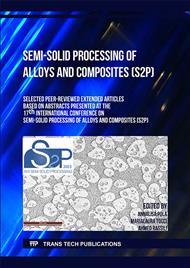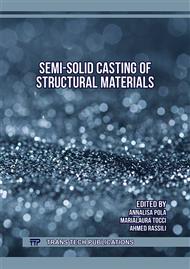p.47
p.53
p.61
p.67
p.75
p.83
p.91
p.97
p.107
Abrasive Wear Properties Evaluation of the Thixoformed A380/NbC Composite
Abstract:
Composite materials are increasingly being used in several areas, especially in the automotive and aerospace industries, however, during regular operation their wear is one of the main causes of failure. Consequently, developing and researching new composite materials is essential to increase and improve service life. In addition, thixoforming is claimed to exhibit superior properties by reducing typical defects in casting like shrinkage and porosity. Therefore, the main objective of this study is to produce and analyze abrasion wear properties of the thixoformed aluminum matrix composite reinforced with NbC, obtained by the stir-casting method. Three different composites with 5 wt.%, 10 wt.%, and 15 wt.% of NbC were manufactured with the stir-casting method, compared with A380 alloy. The procedure involves an A380 aluminum alloy that was molten at 750 °C. In sequence, niobium carbide powder was added by mechanical stirring for 10 min; Mg was added to improve the wettability between the reinforcement and matrix. Chemical grain refinement by Al-5Ti-1B master alloy was used for non-dendritic feedstock production. Hence, the induction furnace was used for the thixoforming process, to achieve a mushy of 60 % solid fraction at 562 °C, determined by Differential Scanning Calorimetry (DSC) analysis. The holding time applied was 90s. Optical microscopy (OM) and scanning electron microscope (SEM) analyses allowed the microstructural characterization. Abrasive wear tests, according to the ASTM G65 standard, showed an improvement of the composites’ abrasion wear resistance after the thixoforming process, with a higher amount of NbC, potentially increasing the range of use of this technology and materials.
Info:
Periodical:
Pages:
75-81
Citation:
Online since:
August 2023
Price:
Сopyright:
© 2023 Trans Tech Publications Ltd. All Rights Reserved
Share:
Citation:



